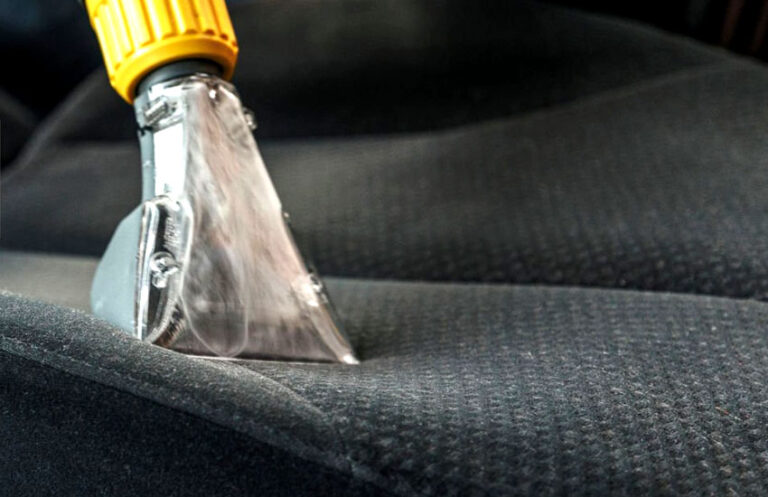As an Amazon Associate, I earn from qualifying purchases at no extra cost to you.
How to Clean Throttle Body Without Removing It: Expert Guide
You might have noticed your car acting a bit sluggish or idling rough. You wonder if your throttle body needs cleaning but don't want to take it apart. You're in luck! Cleaning your throttle body without removing it is easier than you think, and it can improve your car's performance quickly. In this article, I'll show you simple, step-by-step ways to clean your throttle body safely while it's still in place.
Understanding the Throttle Body and Why Cleaning It Matters
Your car's throttle body controls how much air goes into the engine. Think of it as a gate that opens and closes when you press the gas pedal. Over time, dirt, dust, and carbon can build up on this gate and the surrounding parts. When this happens, your engine doesn't get the right amount of air, which can cause rough idling, poor fuel economy, and even stalling.
Cleaning the throttle body without taking it out means you don't have to deal with complicated parts or risk breaking something while removing it. Instead, you carefully spray and wipe away the grime while it's still connected to your car. Knowing how it works and why cleaning is important will help you understand why following the right steps matters.
Dirt and carbon inside the throttle body block airflow and affect sensors that tell your car's computer how to run the engine. This can lead to warning lights on your dashboard, bad acceleration, or a rough engine sound. By cleaning the throttle body, you give your engine a fresh start, helping it breathe better and run smoother.
- The throttle body controls airflow to the engine.
- Dirt buildup causes poor engine performance.
- Cleaning it without removal is safer and easier.
- Dirty throttle bodies can cause rough idling and stalling.
- Cleaning improves fuel efficiency and engine smoothness.
Preparing Your Car and Tools for Throttle Body Cleaning
Before you start cleaning, preparation is key. First, find a safe place to work where your car is parked on a flat surface. Make sure the engine is cool to avoid burns or injuries. You will need a few simple tools and supplies that you might already have at home or can buy cheaply.
Gather a throttle body cleaner spray (make sure it's safe for your car), some clean microfiber cloths, a screwdriver to open the air intake hose, and safety gloves and glasses to protect your hands and eyes. Avoid using harsh chemicals or cleaners not made for throttle bodies, as they can damage the parts or sensors.
Next, open your car's hood and locate the throttle body. It is usually found between the air filter box and the engine intake manifold. You may need to remove the air intake hose that connects to the throttle body using a screwdriver to loosen the clamps.
Turn off the engine and disconnect the battery's negative terminal to avoid accidental starts or electric shocks. Once everything is set up, you're ready to clean.
- Park the car on flat ground and let the engine cool.
- Use throttle body cleaner spray and microfiber cloths.
- Have a screwdriver, gloves, and safety glasses ready.
- Locate and access the throttle body by loosening air intake clamps.
- Disconnect battery negative terminal for safety.
How to Spray and Clean the Throttle Body Safely Without Removal
Start by opening the throttle body carefully. You can do this by pressing the gas pedal lightly or using a tool to hold the throttle plate open. This will give you better access to clean inside the throttle body.
Spray the throttle body cleaner on the inside edges and surfaces of the throttle plate and the throttle body walls. Avoid spraying the sensors directly, as they are delicate and can be damaged. Let the cleaner sit for a few minutes to break down the dirt and carbon buildup.
Using a clean microfiber cloth or a soft brush, gently wipe away the dirt and grime. Be patient and thorough, cleaning every visible part inside the throttle body. You might need to spray and wipe several times to get it completely clean.
After cleaning, press the gas pedal a few times to move the throttle plate and remove any leftover cleaner and dirt. This also helps to dry the cleaned parts faster.
- Open the throttle plate gently for better cleaning access.
- Spray cleaner on the throttle body's inside surfaces.
- Avoid spraying sensors directly to prevent damage.
- Use a microfiber cloth or soft brush to wipe dirt off.
- Press the gas pedal several times to clear residue.
Checking and Cleaning the Air Intake Hose and Surrounding Areas
The air intake hose connects your throttle body to the air filter. Dirt and debris can collect inside this hose, causing more trouble for your engine. Cleaning this hose along with the throttle body helps keep the air flow smooth and clean.
Remove the hose carefully after loosening the clamps. Inspect the inside of the hose for dirt, oil, or cracks. If it's dirty, use a damp cloth or throttle body cleaner sprayed on a cloth to wipe the inside. Avoid soaking the hose or using harsh chemicals.
Check the air filter box and replace the air filter if it's dirty or clogged. A clean air filter is important because it stops dirt from getting into the throttle body and engine.
After cleaning, reattach the hose tightly and make sure all clamps are secure to avoid air leaks. Loose connections can cause poor engine performance and trigger warning lights.
- Remove and inspect the air intake hose for dirt or damage.
- Wipe the hose inside with a damp cloth or cleaner on cloth.
- Replace the air filter if dirty or clogged.
- Ensure hose and clamps are securely fastened after cleaning.
- Clean hose helps prevent dirt from reaching the throttle body.
Restarting the Engine and Resetting the Throttle Body System
Once the throttle body and hose are clean and reassembled, reconnect your car battery's negative terminal. Before starting the engine, check that all parts are secure and no tools are left inside the engine bay.
Start the engine and let it idle for a few minutes. The engine computer may need some time to adjust to the cleaner throttle body. During this time, you may notice the engine idling a bit rough or higher than usual, but this is normal.
Some cars may require resetting the throttle body system to clear any stored error codes. You can do this by disconnecting the battery for about 15 minutes or using an OBD2 scanner to clear the codes. Check your car's manual or a mechanic if you're unsure.
Observe how your car runs after cleaning. If you notice smoother idling, better acceleration, and no warning lights, the cleaning was successful.
- Reconnect battery and ensure everything is secure.
- Start engine and let it idle to adjust.
- Engine might idle rough briefly—this is normal.
- Reset throttle body system by disconnecting battery or using OBD2 scanner.
- Watch for improved performance and no warning lights.
Maintaining Your Throttle Body for Long-Term Performance
Cleaning your throttle body is a great way to keep your car running smoothly, but regular care helps avoid problems later. Make it a habit to check your throttle body and air intake hose every 20,000 to 30,000 miles or as recommended by your car's manufacturer.
Use good quality air filters and replace them on time to keep dirt out. Avoid driving in very dusty or dirty areas if possible, as this increases grime buildup.
If you notice any symptoms like rough idling, hesitation when pressing the gas, or check engine lights, inspect the throttle body sooner. Sometimes a quick clean can save you from costly repairs.
Finally, keep an eye on your car's performance and fuel efficiency. If you maintain your throttle body well, you'll enjoy better mileage, smoother rides, and a longer engine life.
- Clean throttle body every 20,000–30,000 miles or as recommended.
- Use and replace good air filters regularly.
- Avoid driving in dusty areas when possible.
- Watch for symptoms like rough idling or hesitation.
- Proper care extends engine life and improves mileage.
Final Thoughts
Cleaning your throttle body without removing it is easier than you might think, and it can make a big difference in how your car runs. With some simple tools and a little patience, you can clear away dirt and grime that causes engine problems. Regular maintenance keeps your car smooth, saves fuel, and prevents costly repairs. Just follow the steps carefully, stay safe, and enjoy the feeling of a better-running engine every time you drive.
Frequently Asked Questions (FAQs)
Is it safe to clean the throttle body without removing it?
Yes, it is generally safe to clean the throttle body without removing it as long as you use the correct throttle body cleaner and avoid spraying sensors directly. Make sure your engine is off and cool before you start. Disconnecting the battery prevents any accidental electrical problems. Cleaning it in place helps avoid damaging delicate parts that can happen during removal. If you're careful and follow the right steps, cleaning without removal can be a simple, safe, and effective way to improve your car's performance.
Can I use regular carburetor cleaner to clean my throttle body?
No, it is best to avoid regular carburetor cleaner because it can be too harsh for throttle body parts and sensors. Throttle body cleaners are specially made to remove dirt and carbon gently without harming sensitive components. Using the wrong cleaner might cause damage or leave harmful residues. Always check the label and buy a cleaner designed for throttle bodies to keep your engine safe and working well.
Do I need special tools to clean the throttle body?
No special tools are needed other than basic items like a screwdriver to loosen clamps, throttle body cleaner spray, microfiber cloths, and safety gloves and glasses. These tools are inexpensive and easy to find. Avoid using hard brushes or metal tools that can scratch or damage the throttle body. The process is straightforward and designed for beginners with simple tools.
Is it necessary to disconnect the battery before cleaning?
Yes, disconnecting the negative battery terminal is an important safety step. It prevents accidental engine starts and protects your car's electrical system while you work. It also helps reset the engine control unit if needed after cleaning. Always take this step before you begin cleaning your throttle body.
Can a dirty throttle body cause the check engine light to come on?
Yes, a dirty throttle body can cause the check engine light to turn on because it affects airflow and sensor readings. The engine control unit detects irregular airflow or problems with throttle position sensors and triggers a warning light. Cleaning the throttle body often clears these issues, but if the light stays on, it may mean there's a bigger problem that needs a mechanic's attention.
Do I need to press the gas pedal while cleaning the throttle body?
Yes, gently pressing the gas pedal or holding the throttle plate open helps you reach inside the throttle body to clean all the dirty parts. Moving the throttle plate during cleaning allows cleaner spray to reach areas that are normally hidden. After cleaning, pressing the gas pedal several times helps clear away any leftover cleaner and dirt.
Is cleaning the throttle body enough if my car has poor acceleration?
Cleaning the throttle body helps if poor acceleration is caused by dirt buildup restricting airflow. However, poor acceleration can also be due to other issues like fuel problems, clogged filters, or engine troubles. If cleaning the throttle body doesn't improve your car's performance, you might need a full engine check by a professional.
Can I clean the throttle body too often?
Cleaning the throttle body too often is not usually harmful but isn't necessary either. Over-cleaning can cause wear if done roughly. It's best to clean it only when you notice symptoms like rough idling or every 20,000 to 30,000 miles as part of regular maintenance. Proper care and timely cleaning keep your throttle body and engine in good shape.




